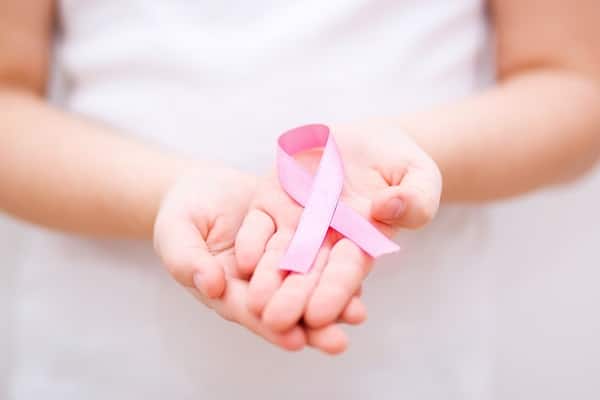
Proton Therapy to Treat Breast Cancer
Diagnosed at age 40, she wanted to reduce long-term risks
As a team manager for an insurance company, Marti Shelton spends a lot of time on the road. Though her annual mammogram in 2014 wasn’t due until December, she arranged to have it a few months early, when she knew she’d be in town.
She didn’t give it much thought — until she got a call from her doctor saying it was abnormal. A second mammogram, followed by a biopsy, confirmed that she had cancer.
“You don’t think at 40 years old you are going to be diagnosed with breast cancer,” says Marti, now 41. “I was in shock.”
She had a few different options. One was a mastectomy, which would require no further treatment. Another was to try a clinical drug trial to shrink the tumor, followed by lumpectomy surgery and radiation. Wanting to conserve her breast, Marti chose the drug trial, and the size of her tumor shrunk from 4 cm to 1 cm.
She then had the lumpectomy, during which her surgeons found that the margins around the tumor were clear of cancer. However, they also removed six lymph nodes, and the cancer had spread to two of them. She wasn’t out of the woods yet.
Marti began to thoroughly research her options.
“For me it was important to know what I was getting,” she says. “There is so much good information available online.”
Her radiation oncologist explained that radiation delivered to healthy tissues around breast tumors can affect the heart and lungs, and may increase the risk of secondary cancers, lung injuries and major cardiac events later in life. When lymph nodes are included in the radiation field, the risk to the heart and lungs is higher. It’s also higher if the tumor is in the left breast — like Marti’s — because of it’s closer proximity to her heart.
A safer option: proton therapy
Marti’s radiation oncologist then mentioned another option: proton radiation therapy. Unlike X-ray radiation that can penetrate surrounding tissue, a proton beam can be controlled to stop precisely where the tumor stops. Studies have found that proton therapy provides better coverage of the lymph nodes while substantially reducing average radiation doses to the heart and lung.
“One of the big things was my age,” Marti says. “I want to live a long life — I don’t want to have a heart attack or heart damage.”
After carefully weighing her options, Marti asked her radiation oncologist what he would recommend if one of his family members were in her place. He told her he would choose proton therapy.
Arizona didn’t have a proton center, so she had two options: Oklahoma or San Diego.
Traveling to San Diego for treatment
“Before this diagnosis, I had never heard of Scripps, but after my first appointment, I knew,” Marti says. “My consultation was with Andrew Chang, MD. He is an amazing man and spent so much time with me. I felt very confident in his ability. And at the end of the consultation, he said, ‘I want to pray with you because I want you to be better.’ When he put his hand on mine and prayed for my health and my safety, I just knew that’s where I wanted to be.”
Marti had 21 treatment sessions at Scripps Proton Therapy Center and was inspired by the caring support of the staff.
“Those girls were amazing,” Marti says. “They always kept me informed, we laughed, they let me listen to whatever music I chose. That let me be in a good, happy place.”
Marti stayed in La Jolla during treatment and continued working from her hotel. She explored the village with friends who came to visit, and spent a lot of time relaxing at the beach.
“I’d take my coffee to Windansea and just enjoy the peacefulness,” she adds. “It was just what I needed.”
She waited until she had finished treatment to tell people that she’d had cancer.
“I didn’t want pity, or people thinking I couldn’t do my job,” notes Marti. “Now when I tell people they cannot believe it. Cancer doesn’t have to look sad.”
She encourages other women who have breast cancer to research their options and get as much information as possible before making a decision about treatment.
“So many women don’t know about proton therapy,” she says. “So many doctors don’t even know about it. It’s your body. Why not go out and know you are getting all the information you can?”
Life after cancer: A beautiful thing
Marti recently ran her first 10K since her treatment, and enjoys hiking the Arizona mountains in the early morning.
“Here in the desert we have these beautiful sunrises. It is just such a beautiful time to go out and hike and have a little bit of peace and quiet before your day starts,” Marti says.
Having cancer, she says, has made her more patient and less intense.
“I notice that things don’t get to me like they used to,” she adds. “I appreciate life a little better. I hope that I can help other people appreciate their life more, and be a positive influence.”

Join our Senior Wellness Society for the latest news on Medicare and tips for healthy living in San Diego!
Sign up now ›Are you looking for specialized medical care in San Diego?
Our directory has more than 850 doctors in San Diego County of various specialties who are available to help you.
Find a doctor